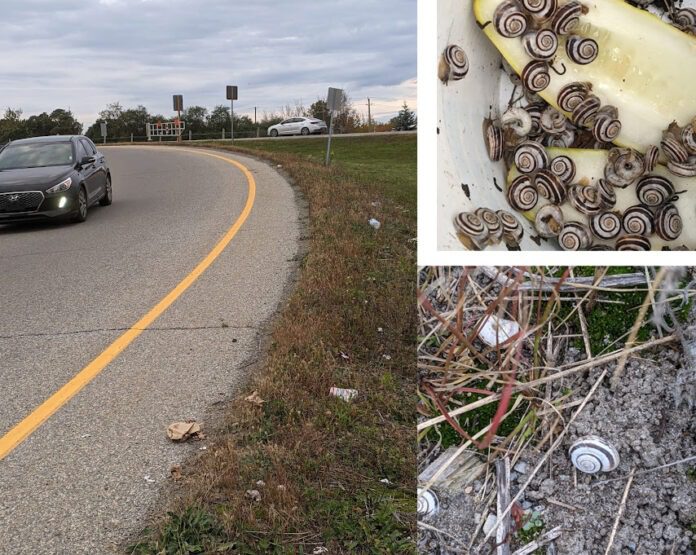

by Fred Schueler, Fragile Inheritance Natural History
When a species has “obvia” as its specific epithet, and it’s so conspicuous that you can survey its occurrence along a highway at 30 km/h, the English name is obvious. Xerolenta obvia (conventionally translated as ‘Heath Snail’) lives in open, disturbed limey places with grasses and herbs, often in enormous numbers. It has a “medium-sized (to 19 mm), flattened shell, dull to slightly shining, white or grey-white with a single broad brown spiral band and paler, less distinct bands below that. It is native to Asia Minor and central Europe.” It was first discovered in Canada in 1969 near Bethany, along Hwy 7a and an abandoned railway, and at that time it was speculated to have been introduced there in the 1940s. Many other populations have since been found south and west of Peterborough.
We’d been following the range of Xerolenta around Bethany since 1992, but we first heard of it in eastern Ontario in 2009, when Ross Layberry found it around the quarry and along old Hwy 17 at Breezy Heights Road. We went there in November and found thousands and thousands of shells, scattered over the pale shattered limestone around the quarry and along the road.
Then, on July 20, 2017, we found many shells and adults “NW of County Road 43/416 interchange, 2.12 km NE Kemptville,” on the gravel shoulder of this “brushy superhighway interchange, among Yarrow, Carrot, old Parsnip stems, White Sweet-clover, and quite a diverse weedy plant community.” It was rather astonishing to find this conspicuous species that we’d been tracking all across southern Ontario in our backyard.
We’ve since found them along CR 43 from the 416 exit ramp across from the Walmart to 325 m E of the median of the 416. So far, we’ve only found it within the interchange, but we haven’t carefully surveyed the shoulders of the 416 under the overpass.
This spring, we learned that Rory McDonnell and colleagues at the Department of Crop and Soil Science at Oregon State University were conducting population genetics on Xerolenta obvia to determine genetic diversity within and among North American populations, and the relations of North American and European populations. With Judy Courteau, we’ve collected samples from Kemptville and Breezy Heights for this study. Ken & Janet Storey at Carleton University are working on freeze tolerance as an over-wintering strategy in snails, and we’ve collected a sample of Xerolenta for them.
So, while these snails are obvious if you’re near them, it can be dangerous to get near them along a 400-series highway, or along the terrific traffic along CR 43. At Breezy Heights, you can safely see hundreds of shells in every square metre between the road and the quarry, but, so far, the Kemptville population hasn’t spread very much along CR 43 since we first surveyed them in 2017.
The species was first observed in Montana 2012, and because it “readily attaches to hard surfaces such as rail cars, international shipping containers, stone and granite tile, and other conveyances used in international trade… [it] is regarded as a pest, because it has the potential to reduce crop yield and quality, contaminate fruits, vegetables, and hay, and transmit plant and animal diseases”, but none of these outcomes have been observed in the 70 years it has been in Ontario.
Since Xerolenta occur along a variety of roadside habitats along CR 43, we have to assume that they’ll eventually spread to many roadside habitats, and every time we stop along a highway for a cellphone call or to check on navigation, we record that Xerolenta is (so far) absent. If others want to help with this prospective survey, or to find new populations, you can send us the GPS latitude & longitude (with date & time and a brief habitat description) of places you’ve stopped along highways and have seen, or not seen, the snails. When they are present, they’re usually so abundant that they’re obvious on the gravel of the roadside, and can just be observed through the passenger-side window without getting out of the vehicle.






here are Internet links for this article: there is background, and photos, of the species at https://www.mollus.ca/canada-snails/geomitridae/xerolenta-obvia/ and scroll down to 2015 at https://www.mollus.ca/my-publications/ for “Forty years later: distribution of the introduced Heath Snail, Xerolenta obvia in Ontario, Canada (Mollusca: Gastropoda: Hygromiidae).” Check List 11(4): 1711. [7 August 2015]. → doi: https://doi.org/10.15560/11.4.1711 The Montana quote is from https://fieldguide.mt.gov/speciesDetail.aspx?elcode=IMGASE0040